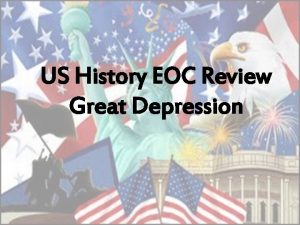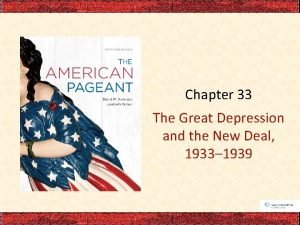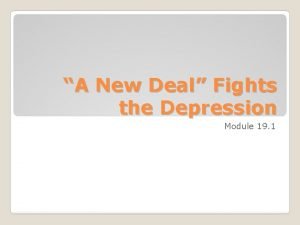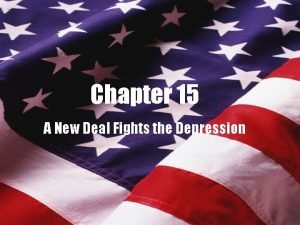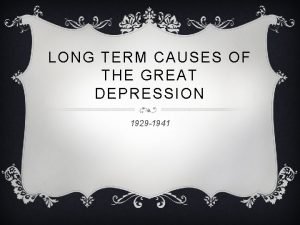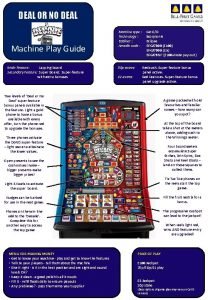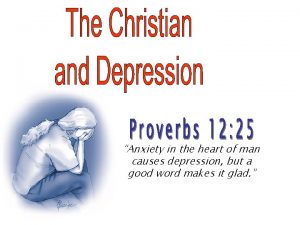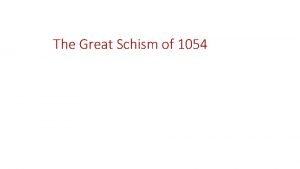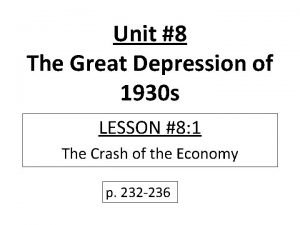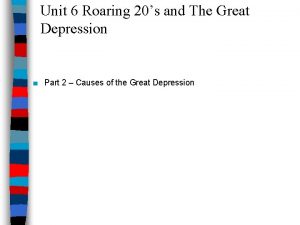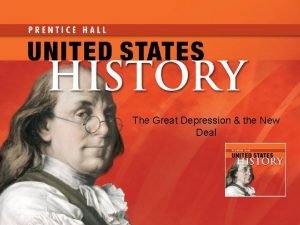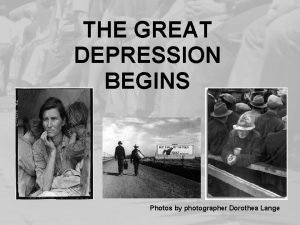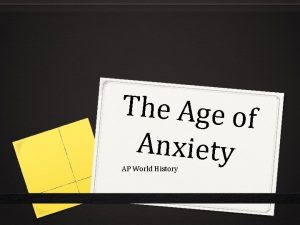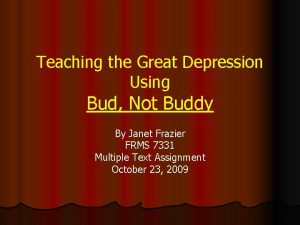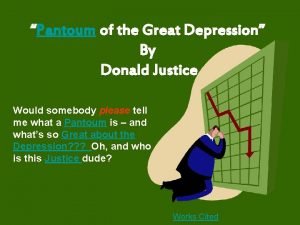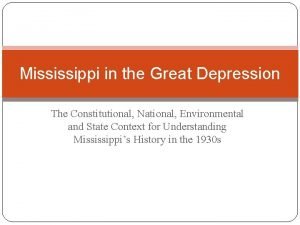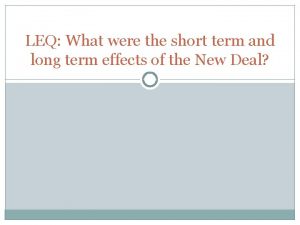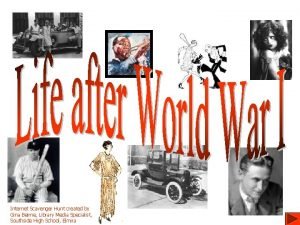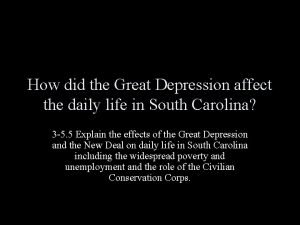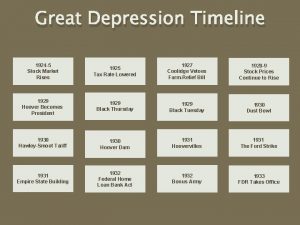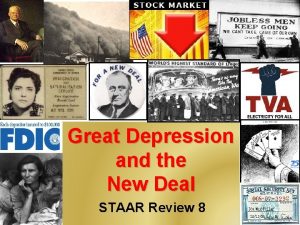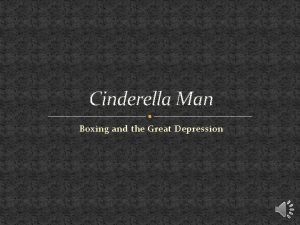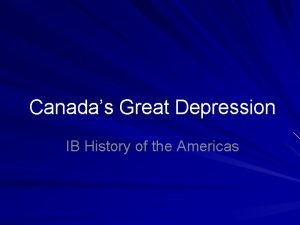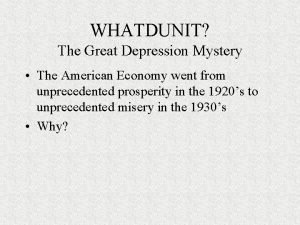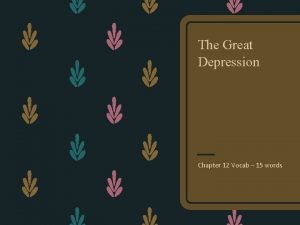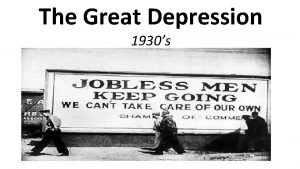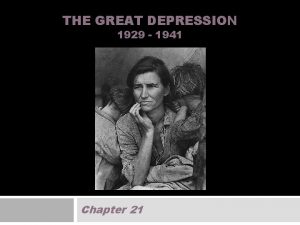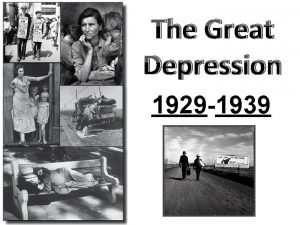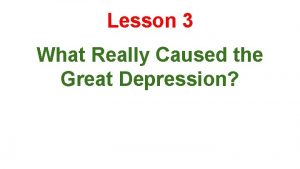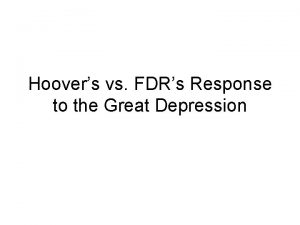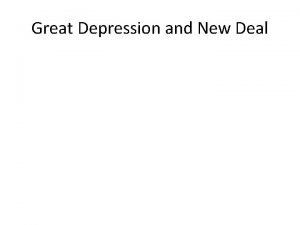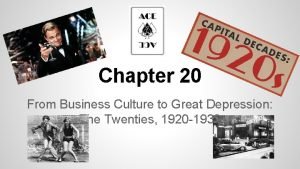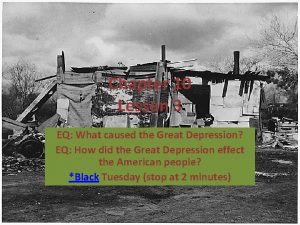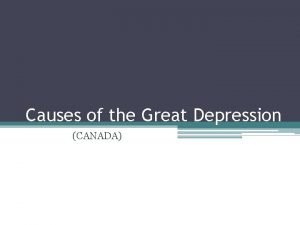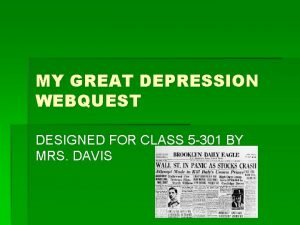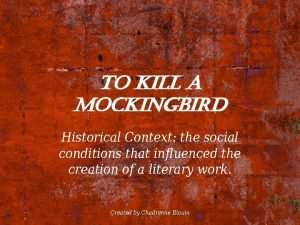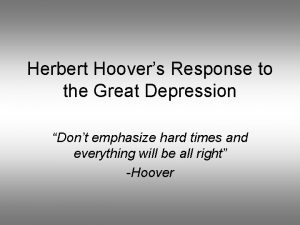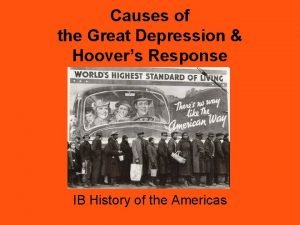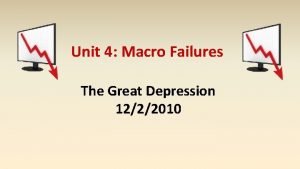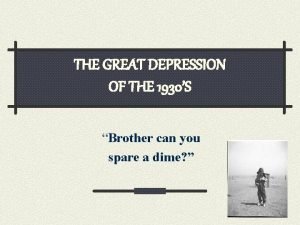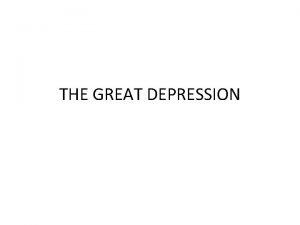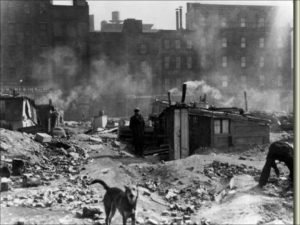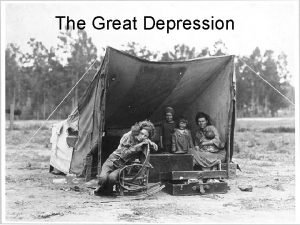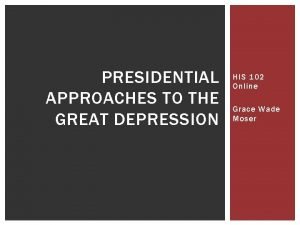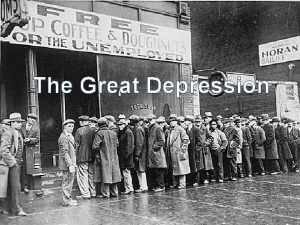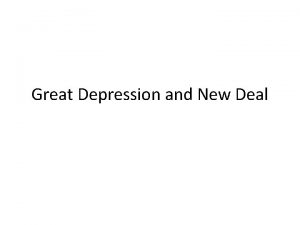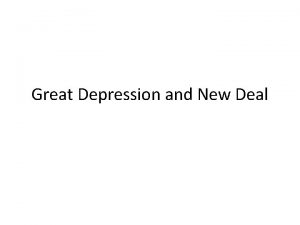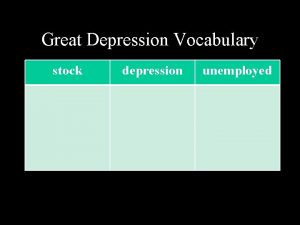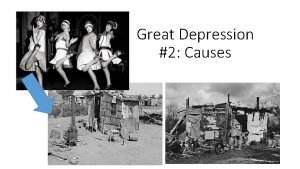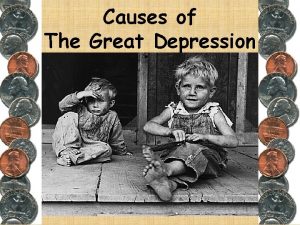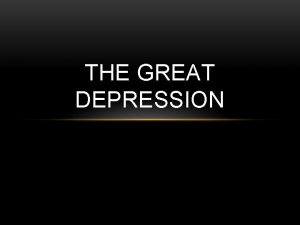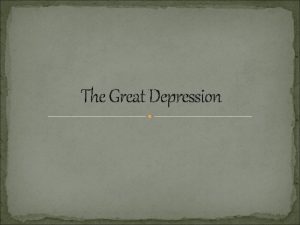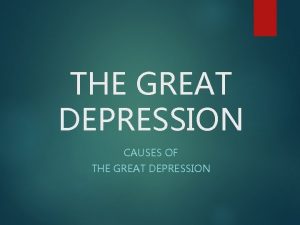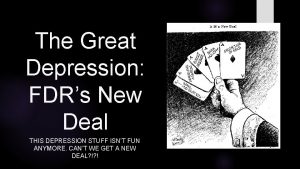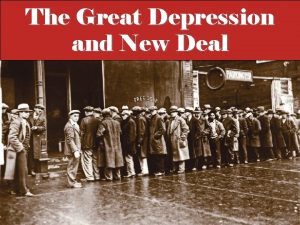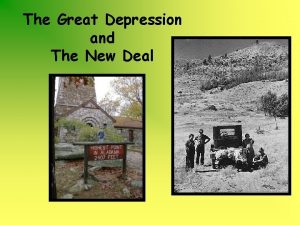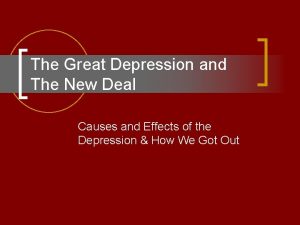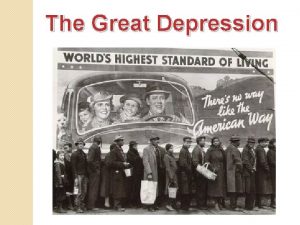The Great Depression and The New Deal Causes





































































- Slides: 69

The Great Depression and The New Deal

Causes of the Great Depression • • Tariffs and war debt policies Crises in the farm sector Availability of easy credit Unequal distribution of income

Hoover Takes the Nation • Election of 1928 – Herbert Hoover v. Alfred E. Smith – Hoover wins the election easily and becomes the 31 st president of the United States

Living on Credit • Credit – buy now pay later – usually with high interest rates • Faced with rising debt, many consumers started cutting back on spending (slowed the economy)

Economic Troubles on the Horizon • Industries in trouble: – Mining and lumbering – Railroads – Radio – Steel – Automobiles • All of these industrial weaknesses signaled a declining economy

Agriculture and the Farmers • Prices for crops had been at an all-time high during WWI • After the war prices dropped by over 50% – A lot of farmers were unable to repay their loans and lost their farms

Uneven Distribution of Income • More than 71% of the population earned less than $2500 per year • The rich were getting richer and the poor were getting poorer

Stock Market • • • Speculation – people were buying stocks and bonds on the chance of a quick profit while ignoring risks Buying on margin – paying a small percentage of a stock’s price as a down payment and borrowing the rest Both speculation and buying on margin caused stock prices to rise – They caused over-investment because people bought more than they could pay for

The Stock Market Crashes • Black Tuesday – October 29, 1929 – A record 16. 5 million shares were sold – Millions more could not find buyers – People who had bought stock with loans were stuck with huge debt and unable to pay

Financial Collapse • The stock market crash was the first sign of the Great Depression – Period between 1929 and 1940 in which the economy plummeted and unemployment skyrocketed – The Great Depression was not just isolated to America – it was felt around the world

Bank and Business Failures • Banks also invested in the stock market – and they too lost their money • In 1929 around 600 banks closed – people could not get their money from the bank • By 1933 11, 000 of the nation’s 25, 000 banks had failed and lost their money – Millions of Americans lost all they had

Unemployment • 1 out of every 4 Americans did not have a job by 1933 • Those who did have a job were working for very little money with very little hours

Hoover Struggles with the Depression

Hoover’s Cautious Steps • Asked employers not to cut wages • Asked employers not to lay off workers • Asked workers not to go on strike • In the end, none of these steps were working

Hawley-Smoot Tariff • 1930 • Established the highest protective tariff in United States history • Designed to protect American farmers and manufacturers from foreign competition • But had the opposite effect…. .

Hawley Smoot Tariff cont… • By reducing the flow of goods in to the U. S. other countries lost revenue – which they were using to repay their loans to the United States • Also made unemployment higher • World trade declined almost 50%

Reconstruction Finance Corporation (RFC) • Agency established in 1932 • Provided emergency financing to banks, life insurance companies, railroads, and other large businesses • “Trickle-Down”

“Hoovervilles” • Americans started calling all the shantytowns that had popped up “Hoovervilles” • Directed at the president for not doing enough for the poor during the depression

Bonus Army • Between 10, 000 and 20, 000 WWI veterans (1932) • Gathered in Washington to demand their pay promised to them and their families for time served in WWI • Most dispersed in peace • The ones that stayed are gassed and pushed away with force • This incident made Americans dislike Hoover even more

Boulder Dam • • Later renamed Hoover Dam Started in 1930 – completed in 1936 30 miles from Las Vegas Provided jobs & water/electricity to SW

Hardship and Suffering During the Great Depression

Depression in the Cities • People lost their jobs • Evicted from their homes • Ended up with nothing, wandering the streets • Shantytowns – little towns consisting of shacks (built out of anything they could throw together for shelter)

Depression in the cities cont…. • Soup kitchens – offered free or lowcost food • Bread lines – lines of people waiting to receive food – Usually provided by charities or public agencies

Minorities during the Depression • Often had it harder than did whites • Suffered higher unemployment • Lower pay • And racial violence

Depression in Rural Areas • Had one advantage over living in the city: – Some farmers were able to grow their own food • However, with falling prices, rising debt, and the drought, many farmers lost their land • Between 1929 and 1932 over 400, 000 farms were lost through foreclosure

The Dust Bowl • Regions that were hardest hit: – Kansas – Oklahoma – New Mexico – Colorado – Texas • Farmers had cultivated so much land that there was nothing to hold the soil down • Exhaustion of the land from overproduction

Women and Children during the Depression • Women – Had to manage tight household budgets; encountered opposition in holding jobs outside the home • Children – Suffered from poor diets and inadequate healthcare; many welfare programs and schools were shut down

The New Deal

Franklin Delano Roosevelt • Elected president in 1932 • Served longest term of all the presidents (12 years)

Roosevelt’s New Deal • New Deal policies focused on three general goals: – Relief (for the needy) – the immediate effort to help the one-third of the population that was hardest hit by the depression – Economic recovery – the effort in numerous programs to restore the economy to normal health – Financial reform – government intervention to stabilize the economy, and to balance the interests of farmers, business and labor

The First 100 Days • March 4 th – June 16 th • Roosevelt and Congress passed more than 15 major pieces of New Deal legislation

The “Bank Holiday” • Roosevelt closed all the banks on March 5 th • Passed the Emergency Banking Act – Banks could only be re-opened under the Treasury Departments supervision – Federal loans were handed out as needed • Helped restore the publics confidence in the nation’s banking system

Regulating Banking and Finance • Glass-Steagall Act (1933) – Established the Federal Deposit Insurance Corporation (FDIC) – Provided federal insurance on each bank account – Restored confidence to the customers with the banks

Federal Securities Act (1933) • Required corporations to provide complete information on all stock offerings • Created the Securities and Exchange Commission to regulate stock market

Help for the Farmers • Agricultural Adjustment Act (AAA) – Sought to raise crop prices by lowering production – The government paid farmers to leave some of their land fallow (unseeded) – This lowered production which in turn raised crop prices

New Deal Projects • Civilian Conservation Corps (CCC) – Put young unemployed men to work building roads, developing parks, planting trees, and helping in soil-erosion and flood-control projects

National Industrial Recovery Act (NIRA) • Established codes of fair practice for Industries and to promote industrial growth • Example: – Public Works Administration (PWA) Provided money to states to create jobs chiefly in the construction of schools and other community buildings

Food Clothing and Shelter • Home Owners Loan Corporation (HOLC) – Provided government loans to homeowners who faced foreclosures • Federal Housing Administration (FHA) – Furnishes loans for home mortgages and repairs • Federal Emergency Relief Administration (FERA) – Provided direct relief for the needy

Deficit Spending • Spending more money than the government receives in revenue • FDR regarded deficit spending as a “necessary evil” to bring the United States out of the depression

The Supreme Court Reacts • 1935 found the NIRA to be unconstitutional • 1936 found the AAA to be unconstitutional and struck it down

FDR vs. Supreme Court • Supreme Court in the early 1930’s was more conservative (did not favor New Deal) & declared many programs unconstitutional • In 1937 FDR proposed a Congressional bill to reorganize the Supreme Court calling for 6 new justices (And by law, he gets to appoint those justices!!!) • Congress and press were outraged at his “Court-Packing” Bill – Why? • Eventually he gets his way as several justices over the next 4 years retire

The Second New Deal Takes Hold

The Second Hundred Days • Economy had improved during FDR’s first 2 years as president • He still wanted more improvement – Unemployment rates remained high – Production still lagged behind 1920’s levels • Roosevelt decided to launch a Second New Deal another burst of activity aimed at providing more help for farmers and workers

Eleanor Roosevelt • The First Lady (FDR’s wife) • Helped her husband out every chance she got – very important part of the second new deal

Reelecting FDR • 1936 presidential election – FDR (democrat) vs. Alfred Landon (republican) • Overwhelming victory by FDR

Helping Farmers • Soil Conservation and Domestic Allotment Act – Paid farmers for cutting production • 1938 – Second Agricultural Adjustment Act – Did not include a previous processing tax to pay for farm subsidies

Works Progress Administration (WPA) • Designed to help the nation’s youth, professionals, and other workers • Headed by Harry Hopkins • Provided the unemployed with jobs in construction, garment making, teaching, arts, and other fields

National Youth Administration (NYA) • Created to provide education, jobs, counseling, and recreation for young people • Also provided financial aid for high school, college, and graduate school

Wagner Act • Reestablished the NIRA provision of collective bargaining • Protected the rights of workers • Allowed them to join unions without pressure from management

Social Security Act • 1935 • 3 major parts: – Old-age insurance for retirees 65 or older and their spouses – Unemployment compensation system – Aid to families with dependent children and the disabled

The New Deal Affects Many Groups

New Opportunities • Several Women appointed to government positions • Frances Perkins first female Cabinet Member (Secretary of Labor)

African-American Activism • 1930’s saw growth of activism for African Americans • Laid groundwork for Civil Rights Movement (1950’s-60’s) • “Black Cabinet” – Group of influential African Americans to advise Roosevelt on racial issues.

Culture in the 1930’s

Motion Pictures and Radio • Very profitable during the 1930’s • By 1940 65% of Americans were attending the movies at least once a week • 90% of American households owned a radio

Movies • 1939 • Two of the most popular films of all time • Acted as a “get-a-way” from the everyday hardships of the Great Depression

Fireside Chats • Families usually spent several hours a day together listening to the radio • Allowed FDR to speak directly to the people. • Spoke to them as if he were a friend, not the President. • Comforted the common man

Orson Welles • Actor, director, producer, and writer • Created “War of the Worlds” (1938)

Grant Wood • American painter • Painted “American Gothic” – 1930 • FDR appointed writers and artists to paint murals to cheer up Americans

The Grapes of Wrath • 1939 • Written by John Steinbeck – Also received assistance from the Federal Writer’s Project • About the lives of a group of people from Oklahoma and their hardships during the Dust Bowl

The Impact of the New Deal

New Deal Reforms • During 2 nd Term in office FDR sought to create a Third New Deal • FDR did not favor deficit spending • Economy had slightly recovered, and Congress pressured FDR to scale back the New Deal • Caused more unemployment • By 1939, FDR more concerned with Europe (Hitler’s Rise in Germany)

Critics of New Deal • Critics – Typically Conservatives – New Deal Made Federal Government too large – Government stifled free enterprise and individual initiative – Liberal Critics claimed that Roosevelt did not go far enough

Supporters of the New Deal • Supporters – Typically Liberals – FDR Struck a reasonable balance between two extremes (unregulated capitalism and overregulated socialism) – Helped Country recover from economic difficulties

Deep Debt • Federal Government had to go deeply into debt to provide jobs and help Americans

Lasting Effects • Workers Rights – National Labor Relations Board • Acts as a mediator in labor disputes between Unions and Workers • Still Around today • Banks and Finance – FDIC – Banking regulations and protection – SEC – Monitors stock market

Lasting Effects • Social Security – One of the most important legacies of New Deal – Old Age insurance and unemployment continues to help families. – Impacted millions of Americans since 1935 • Rural Scene – AAA – Helped farmers keep farms. – Rural Electrification Administration (REA) – Provided electricity to people in rural areas.

Lasting Effects • Environment – Tennessee Valley Authority (TVA) – Provided jobs to thousands of workers in the region – Prevented floods in the Tennessee Valley – Provided cheap electricity to the region

New Deal Legacy • Brought hope and gratitude to some people for the benefits and protections • Also brought criticism from those who believed it took too much of their money in taxes. • United States does not fully recover until after World War II
 Great depression vocabulary
Great depression vocabulary Main idea
Main idea Chapter 33 the great depression and the new deal
Chapter 33 the great depression and the new deal A new deal fights the depression
A new deal fights the depression Chapter 15 section 1 a new deal fights the depression
Chapter 15 section 1 a new deal fights the depression Great depression causes
Great depression causes What were the long term causes of the great depression
What were the long term causes of the great depression A great deal vs a great many
A great deal vs a great many Deal or no deal machine
Deal or no deal machine Asset deal vs share deal
Asset deal vs share deal Compare and contrast hoover and fdr
Compare and contrast hoover and fdr Anxiety in the heart of man causes depression
Anxiety in the heart of man causes depression Module 9 lesson 2
Module 9 lesson 2 Pros and cons of the great depression
Pros and cons of the great depression New deal political cartoons and explanations
New deal political cartoons and explanations Benjamin west contributed a great deal to american art: …
Benjamin west contributed a great deal to american art: … What was the deal breaker in the great schism
What was the deal breaker in the great schism Rarig great depression
Rarig great depression Great depression
Great depression Sec the great depression
Sec the great depression Foreclosure great depression
Foreclosure great depression Five effects of the great depression
Five effects of the great depression Five effects of the great depression
Five effects of the great depression How did the great depression impact the world
How did the great depression impact the world Dawes plan
Dawes plan Bud not buddy great depression
Bud not buddy great depression Pantoum of the great depression analysis
Pantoum of the great depression analysis The great depression summary
The great depression summary What is deflation
What is deflation Okies great depression
Okies great depression The great depression leq
The great depression leq Five effects of the great depression
Five effects of the great depression How did the great depression affect south carolina
How did the great depression affect south carolina What caused the dust bowl
What caused the dust bowl Mexican repatriation apush
Mexican repatriation apush Hoovervilles
Hoovervilles Birth rate during the great depression
Birth rate during the great depression Overspeculation great depression
Overspeculation great depression Great depression vocab
Great depression vocab Great depression vocabulary
Great depression vocabulary Poverty during the great depression
Poverty during the great depression Http://www.history.com/topics/great-depression
Http://www.history.com/topics/great-depression Great depression
Great depression Hawley-smoot tariff great depression
Hawley-smoot tariff great depression Stock market crash 1929 political cartoon
Stock market crash 1929 political cartoon Lesson 3 effects of the great depression
Lesson 3 effects of the great depression Hoover v. fdr: responses to the great depression
Hoover v. fdr: responses to the great depression Laissez faire great depression
Laissez faire great depression Laissez faire great depression
Laissez faire great depression From business culture to great depression
From business culture to great depression Great depression acrostic
Great depression acrostic Hoovervilles great depression
Hoovervilles great depression Great depression political cartoons
Great depression political cartoons Depression jeopardy
Depression jeopardy Chapter 22 the great depression begins
Chapter 22 the great depression begins Great depression
Great depression Great depression webquest
Great depression webquest Great depression date
Great depression date What was hoover's response to the great depression
What was hoover's response to the great depression Great depression
Great depression What was hoover's response to the great depression
What was hoover's response to the great depression Great depression
Great depression Great depression
Great depression Great depression drawing
Great depression drawing High tariffs great depression
High tariffs great depression Great depression photographer
Great depression photographer What was hoover's response to the great depression
What was hoover's response to the great depression Great depression
Great depression Hoovers poor farm tobacco fund
Hoovers poor farm tobacco fund The great depression outline
The great depression outline

